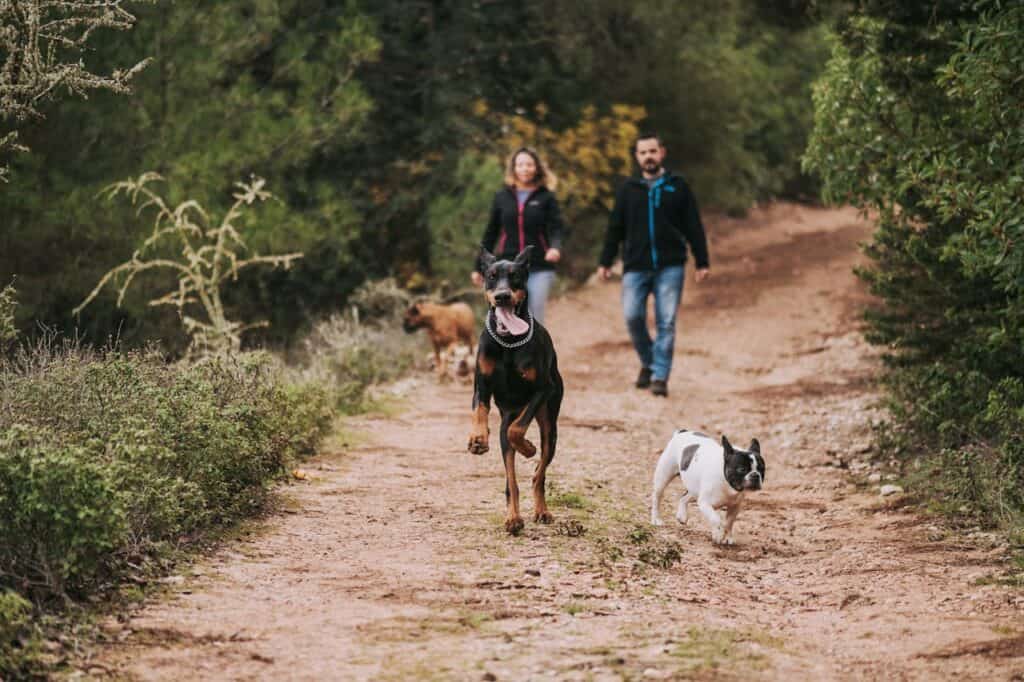1. Introduction
Brief Overview of the Doberman Pinscher
The Doberman Pinscher, commonly known simply as the Doberman, is a sleek, powerful, and intelligent breed that has gained a reputation for its loyalty and protective instincts. Originally bred in Germany by Karl Friedrich Louis Dobermann in the late 19th century, this breed was developed to serve as a reliable guard dog and companion. Dobermans are known for their elegant and muscular physique, high energy levels, and keen intelligence, making them well-suited for various roles, including police and military work, search and rescue, and as loyal family pets.
Key Characteristics and Traits
Dobermans are medium to large-sized dogs with a distinctive appearance marked by their athletic build, pointed ears, and docked tails (in some countries). They are highly intelligent and quick learners, which makes them exceptionally trainable. Their temperament is characterized by loyalty, bravery, and alertness, often making them excellent protectors. Dobermans are also known for their affectionate and playful nature with their families, displaying a balance of protective instincts and loving companionship.
2. Deep Scientific Insights of the Doberman Pinscher
Cognitive Abilities and Intelligence
Dobermans rank highly among the most intelligent dog breeds. According to Stanley Coren’s research on canine intelligence, Dobermans are capable of learning new commands in fewer than five repetitions and exhibit a high rate of obedience. Their problem-solving skills and ability to understand complex tasks make them effective in roles that require quick thinking and adaptability. Studies have shown that Dobermans possess strong working intelligence, enabling them to excel in obedience training, agility, and other canine sports.
Detection Skills and Olfactory Research
Dobermans have a keen sense of smell, which, although not as highly developed as that of some other breeds like Bloodhounds, is still quite impressive. Research conducted by the University of Pennsylvania’s Working Dog Center has demonstrated that Dobermans can be trained to detect specific scents associated with substances such as drugs and explosives, making them valuable assets in detection roles. Their olfactory capabilities, combined with their intelligence and trainability, make them suitable for various scent detection tasks.
Behavioral Genetics and Temperament
The temperament and behavior of Dobermans are influenced by a combination of genetics and upbringing. Studies have identified specific genes associated with traits such as aggression, sociability, and trainability. Research from the University of Cambridge has highlighted the role of the serotonin transporter gene (SLC6A4) in influencing anxiety-related behaviors in Dobermans. Understanding these genetic influences helps breeders and owners manage and cultivate the desirable traits of the breed, ensuring well-balanced and well-socialized dogs.
Role in Medical Therapy and Assistance
Dobermans, with their intelligence and sensitivity, can serve effectively in various medical and therapeutic roles. Studies from the Mayo Clinic and other institutions have shown that therapy dogs, including Dobermans, can provide significant emotional and psychological benefits to patients. Their ability to sense changes in human emotions and their eagerness to please make them effective companions for individuals dealing with anxiety, PTSD, and other conditions. Dobermans can also be trained as service dogs, assisting individuals with disabilities by performing tasks that enhance their quality of life.
3. History and Origin
Origin of the Doberman Pinscher
The Doberman Pinscher was developed in the late 19th century by Karl Friedrich Louis Dobermann, a tax collector and dogcatcher from Apolda, Germany. Dobermann sought to create a breed that could provide protection while he carried out his duties. By selectively breeding several dog breeds, including the Rottweiler, German Pinscher, Greyhound, and Weimaraner, he succeeded in developing a dog with the ideal combination of strength, speed, and intelligence. The breed was officially recognized by the German Kennel Club in 1900.
Historical Roles and Significance
Historically, Dobermans were utilized as guard dogs, police dogs, and military dogs due to their protective nature and trainability. During World War II, Dobermans served alongside soldiers, performing roles such as sentry duty, message delivery, and search and rescue. Their bravery and loyalty earned them the nickname “Devil Dogs” among the United States Marine Corps. Today, Dobermans continue to excel in various working roles while also being cherished as loyal family pets.

4. Physical Characteristics
Size and Weight of the Doberman Pinscher
Dobermans are medium to large-sized dogs. Males typically stand between 26 to 28 inches tall at the shoulder and weigh between 75 to 100 pounds. Females are slightly smaller, standing between 24 to 26 inches tall and weighing between 60 to 90 pounds. Their strong and athletic build gives them a powerful and elegant appearance.
Coat Type and Color
Dobermans have a short, smooth coat that lies close to the body. The coat is easy to maintain and provides a sleek, polished look. The breed standard recognizes four primary coat colors: black, red, blue, and fawn, each with rust-colored markings on the face, chest, legs, and under the tail. Regular grooming helps keep their coat in excellent condition and reduces shedding.
Distinctive Features
Dobermans have a distinctive appearance characterized by their wedge-shaped head, almond-shaped eyes, and well-muscled body. Their ears are typically cropped (in some countries) and their tails docked, giving them a sharp and alert look. However, in many countries, ear cropping and tail docking are banned, and Dobermans are seen with natural ears and tails. Their overall appearance exudes power, elegance, and readiness.
5. Temperament and Personality
General Behavior and Traits of the Doberman Pinscher
Dobermans are known for their loyalty, bravery, and intelligence. They are highly trainable and thrive on mental and physical stimulation. Dobermans are protective by nature, making them excellent guard dogs. However, they are also affectionate and playful with their families, often forming strong bonds with their owners. They are known for their confidence and can be quite social with proper training and socialization.
Interaction with Family, Children, and Other Pets
Dobermans are generally good with children and can be gentle and protective companions. However, due to their size and strength, interactions with young children should always be supervised to prevent accidental injuries. With proper socialization, Dobermans can get along well with other pets, though their strong prey drive may sometimes be a challenge with smaller animals. Early and consistent socialization is key to ensuring harmonious interactions with other pets.
6. Health and Common Diseases
Typical Lifespan of the Doberman Pinscher
The typical lifespan of a Doberman Pinscher is around 10 to 12 years, though some can live longer with proper care and a healthy lifestyle. Regular veterinary check-ups, a balanced diet, and appropriate exercise are essential to ensure their health and longevity.
Common Health Issues and Genetic Conditions
Dobermans are prone to several health issues, some of which are hereditary. Common problems include hip dysplasia, cardiomyopathy (a serious heart condition), and von Willebrand’s disease (a blood clotting disorder). They are also susceptible to hypothyroidism and certain types of cancer. Regular health screenings, responsible breeding practices, and early detection can help manage these risks and maintain the breed’s health.
7. Care and Grooming
Grooming Needs of the Doberman Pinscher
Dobermans have relatively low grooming needs due to their short coat. Regular brushing helps remove loose hair and maintain their coat’s health and shine. They shed moderately throughout the year, and more frequent brushing during shedding seasons can help manage this. Regular baths, nail trimming, and ear cleaning are important to keep them clean and comfortable. Checking their teeth and providing dental care is also crucial to prevent dental diseases.
Exercise Requirements
Dobermans are an active and energetic breed that requires ample exercise to maintain their physical and mental health. Daily walks, play sessions, and opportunities for more strenuous activities like running, hiking, or agility training are ideal. They thrive on mental stimulation and enjoy tasks that challenge their intelligence, such as obedience training, tracking, and protection work. Without sufficient exercise, they can become bored and develop behavioral problems.
8. Hypoallergenic Status
Whether the Doberman Pinscher is Hypoallergenic
Dobermans are not considered hypoallergenic. They shed throughout the year and produce dander, which can trigger allergies in sensitive individuals. Regular grooming and maintaining a clean living environment can help manage allergens, but they may not be the best choice for people with severe allergies.

9. Nutrition Requirements
Dietary Needs of the Doberman Pinscher
Dobermans require a balanced diet to maintain their health and energy levels. High-quality commercial dog food that meets their nutritional needs is generally recommended. It is important to monitor their weight and adjust portions as needed to prevent obesity, which can exacerbate health issues such as hip dysplasia and heart disease. A diet rich in protein, healthy fats, and a balance of carbohydrates, vitamins, and minerals is essential.
Recommended Food and Supplements
For Dobermans, a diet that includes lean meats, fish, vegetables, and whole grains is recommended. Supplements such as glucosamine and chondroitin can help support joint health, particularly in older dogs or those with a predisposition to joint issues. Omega-3 fatty acids, found in fish oil, can promote a healthy coat and skin. Always consult with a veterinarian before adding supplements to your dog’s diet to ensure they are appropriate for their specific needs.
10. Ideal Owners and Families
Type of Owners Best Suited for the Doberman Pinscher
Dobermans are best suited for experienced owners who can provide them with the exercise, training, and socialization they need. They require a significant time commitment and thrive in homes where they can be part of the family
and participate in various activities. Owners who enjoy outdoor activities such as hiking, running, and obedience training will find Dobermans to be enthusiastic and capable companions.
Compatibility with Families, Singles, Seniors, etc.
Dobermans can adapt well to various living situations as long as their physical and mental needs are met. They are excellent family dogs, known for their protective and loyal nature. Singles and seniors who lead active lifestyles and can provide the necessary exercise and companionship will also find them to be devoted pets. They do best in homes with a yard or access to open spaces where they can run and play.
11. Summary
Summary of Key Points
The Doberman Pinscher is a versatile, intelligent, and loyal breed known for its working abilities and protective nature. They require regular grooming and ample exercise to stay healthy and happy. Dobermans are not hypoallergenic and need a balanced diet to prevent health issues. They are well-suited for experienced and active owners who can provide the attention and activity they thrive on. Despite some common health issues, regular veterinary care and a healthy lifestyle can ensure a long, fulfilling life for these dedicated and hardworking dogs.
Final Thoughts on the Doberman Pinscher
Dobermans are one of the most respected dog breeds for good reason. Their intelligence, loyalty, and versatility make them exceptional companions for a wide range of households. Whether as a working dog or a family pet, the Doberman’s courage, confidence, and unwavering devotion make them a cherished addition to any home. With proper care, training, and socialization, they can be loving and loyal companions for many years.

